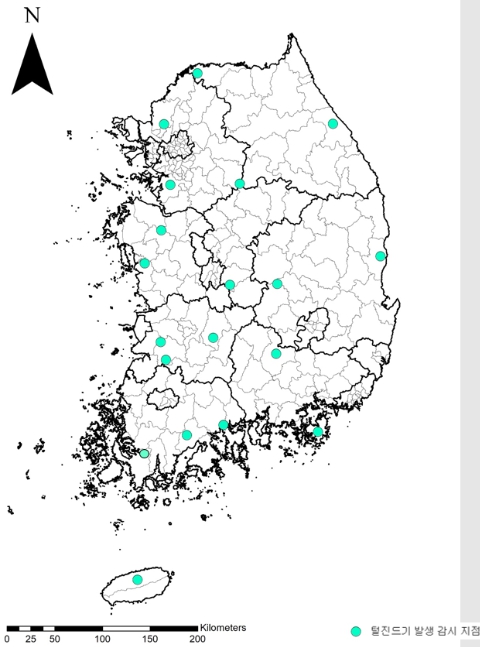 |
| ▲ Monitoring points for hairy mite occurrence in 2024 |
[Global Economic Times] The Korea Disease Control and Prevention Agency announced that it will begin monitoring the density of hairy ticks, a major vector, from August 28 as the high-risk period of scrub typhus infection (October to November) approaches.
Typhus typhus is contracted after being bitten by the larvae of a hairy tick carrying the typhus bacterium. About 6,000 patients occur throughout the year, and the outbreak is particularly concentrated in October and November. Additionally, symptoms such as fever, muscle pain, spotty rash, and lymphadenopathy appear within 10 days after being bitten by a hair tick, and a black scab (eschar) appears at the bite site.
The 'hairy mite surveillance project' is a project to prevent typhus infection by collaborating with the Ministry of National Defense (Armed Forces Medical Research Institute), city/provincial health and environment research institutes (3 locations), and climate change vector monitoring base centers to provide information on hairy mite occurrence to the public. The results of surveys using hair mite collectors in environments where people are likely to come into contact (rice fields, fields, waterways, grasslands) are provided weekly through the website.
A total of 8 types of hairy mites that transmit typhus typhus are known in Korea, and as a result of surveillance in 2023, it was confirmed that the bow-lashed hairy mite occurs mainly in the southern and some northern regions, and the bamboo leaf-haired mite occurs in large numbers in the central and western regions.
Additionally, hair tick larvae begin to appear in early fall (late September to early October) and increase most in late fall (mid-October). Eggs laid in the summer hatch as larvae in early fall and actively search for a host, so the number of cases increases during this period.
Director Ji Young-mi of the Korea Disease Control and Prevention Agency said, “The probability of contact with hair mites may increase during the harvest season and fall foliage season, so minimize exposure to hazardous environments to prevent scrub typhus,” and added, “During agricultural work and outdoor activities, avoid contact with hair mites.” He emphasized, “Be sure to follow precautions such as wearing long sleeves and long pants to avoid being bitten.”
In addition, “Early detection and treatment are important because it can be completely cured with antibiotic treatment in the early stages of typhus typhus infection. If tick bite marks (eschars) are observed after outdoor activities or symptoms such as fever or rash appear within 10 days, typhus typhus may be diagnosed. “If you suspect this, you should visit a medical institution and receive treatment,” he advised.
[Copyright (c) Global Economic Times. All Rights Reserved.]






























